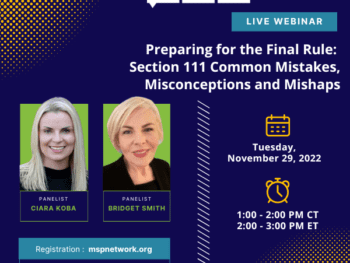Medicare is a government based health insurance program that has provided coverage for countless Americans. While everyone knows something about the program, few know how this program was created and the challenges stakeholders face to ensure the program’s solvency.
Background on Medicare
In 1965, amendments to Title XVIII of the Social Security Act were passed by Congress and later became law. By signing this bill into law, the Medicare program was created as a promise to provide medical insurance for persons over the age of 65 years old, regardless of income. The program currently provides coverage to younger people who have permanent disabilities and receive Social Security Disability Insurance (SSDI) payments, those who have end-stage renal disease (ESRD) and amyotrophic lateral sclerosis (ALS, or Lou Gehrig’s disease).
Considering Medicare’s Interests: Medicare Secondary Payer
The Medicare Secondary Payer Act (MSP) was signed into law on December 6, 1980. There is little legislative history regarding the Act. The MSP has been codified under 42 USC § 1395y (b). It was initially unenforced and ignored by CMS and attorneys settling workers’ compensation and personal injury claims. However, with the aging of the U.S. population becoming more commonplace, the insurance industry and attorneys started to take notice of the Act in the mid-1990s. This was followed by the issuance of policy memoranda by CMS starting in 2001 regarding compliance with Medicare Secondary Payer regulations.
Medicare Expansion with Parts C and D
In 2003, Congress added additional benefits to the Medicare Part C program through the Medicare Modernization Act of 2003 (MMA). Under the MMA, “Medicare+Choice” programs were made more attractive by adding prescription drug coverage, which are now referred to as “Medicare Advantage Plans.” These plans are offered only through private companies known as Medicare Advantage Organizations (MAO). Under this program, private insurance companies are required to offer services and other items not covered under the traditional Medicare program.
Section 111 Reporting
Congress has enacted additional legislation to assist CMS in recouping Medicare’s interest in reimbursement. Under various amendments to the Medicare, Medicaid and SCHIP Extension Act (MMSEA) of 2007, mandatory insurer reporting requirements were enacted, which require all insurers and self-insurers to report those claimants who are receiving Medicare benefits at the time any payment is made on a claim. It is very likely that counsel for the Department of Health and Human Services is looking for a test case on Medicare to use in its enforcement of the Medicare Secondary Payer Act in liability cases.
SMART Act and CMS Processes
During a majority of the 111th and 112th Congresses, the SMART Act received little attention from lawmakers. The bill’s progress was later overshadowed by the impending “fiscal cliff” debate that gripped the United States in late 2012. In the late hours of the 112th Congress, the SMART Act was incorporated via amendment into the Medicare IVIG Access Act (H.R. 1845) and passed with nearly unanimous support. While the SMART Act did not accomplish all that it was hoped for, it does mark increased awareness by congressional leaders of all ideological viewpoints of the importance Medicare plays in our society and the need for reform in the settlement process of personal injury and workers’ compensation cases involving conditional payments.
Conclusion
Now that you have a better understanding of the Medicare program, see how you do on this brief Medicare quiz.
1) Which President signed the Medicare program into law?
A: Lyndon B. Johnson
2) On what date was the Medicare program signed into law?
A: July 30, 1965. Happy 49th birthday, Medicare!
3) Who was the first Medicare beneficiary?
A: Harry S Truman
4) What President signed the Medicare Secondary Payer Act into law?
A: Jimmy Carter
5) Where can the term “Medicare Set-Aside” be found in the United States Code?
A: Nowhere! The term is a legal fiction first coined in the late 1990s to describe a process, which can be used to consider Medicare’s interests in personal injury and workers’ compensation settlements.
Author Michael B. Stack, CPA, Principal, Amaxx Risk Solutions, Inc. is an expert in employer communication systems and part of the Amaxx team helping companies reduce their workers compensation costs by 20% to 50%. He is a writer, speaker, and website publisher. www.reduceyourworkerscomp.com. Contact: mstack@reduceyourworkerscomp.com.
©2014 Amaxx Risk Solutions, Inc. All rights reserved under International Copyright Law.
WORK COMP CALCULATOR: http://www.LowerWC.com/calculator.php
MODIFIED DUTY CALCULATOR: http://www.LowerWC.com/transitional-duty-cost-calculator.php
WC GROUP: http://www.linkedin.com/groups?homeNewMember=&gid=1922050/
SUBSCRIBE: Workers Comp Resource Center Newsletter
Do not use this information without independent verification. All state laws vary. You should consult with your insurance broker, attorney, or qualified professional.












